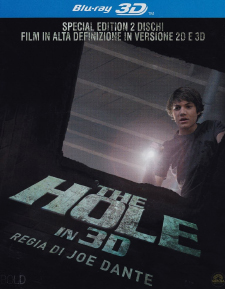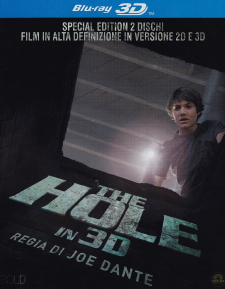Hole, The (Steelbook) (Italian Import) (Region B – Blu-ray 3D Review)

Director
Joe DanteRelease Date(s)
2009 (January 1, 2015)Studio(s)
Big Air Studios (Medusa)- Film/Program Grade: B+
- Video Grade: See Below
- Audio Grade: A-
- Extras Grade: C-
- Overall Grade: B+
Review
[Editor’s Note: This is a Region B-locked Italian import.]
The Hole was Joe Dante’s one and only venture into 3D filmmaking, and unlike many films that are released in the format, the 3D process wasn’t merely an afterthought. Dante had planned the entire project to take advantage of the depth to envelop audiences in the story that he wanted to tell. In fact, it was such an integral part of his vision for the film that he didn’t bother to have any 2D prints struck at all. Ironically enough, that sank The Hole down its own bottomless pit when it was squeezed out of available screens by the proliferation of post-converted 3D films, and Dante’s effort never received a North American theatrical release in 2009 (though it did play in Europe). That’s a shame, because unlike most of those conversion jobs, The Hole really does need to be seen in 3D in order to be fully appreciated.
Mark L. Smith’s script is essentially The Gate by way of Event Horizon, with more than a whiff of Poltergeist thrown into the mix. The story revolves around an overworked single mother (Teri Polo) and her two children (Chris Massoglia and Nathan Gamble), all of whom have just moved into a new house. When the kids open a padlocked door in the basement, they unleash dark forces, and together with their new neighbor, (Haley Bennett), they need to find a way to close Pandora’s Box. So far, so The Gate, but in this case the portal doesn’t unleash hellish minions into the world. Instead, the terrors here are of a far more personal sort, bringing the most intimate fears to life for those who gaze into the abyss—and yes, an inevitable creepy clown doll is involved at one point. Some fears are both personal and universal.
The interesting thing about The Hole is that aside from the obvious (yet effective) clown, the fears that are being manifested are primarily of a much more individualized sort. They’re deep-seated anxieties that result from having unresolved emotional baggage due to past traumatic experiences. The only way for the kids to conquer their fears is by letting go of that baggage and moving on, and that’s what gives The Hole far more resonance than the typical “it knows what scares you” type of horror film. (That’s also why it has more in common with Event Horizon than it does with Poltergeist, clown dolls excepted.)
One reason why the core concept works so well in The Hole is that Dante largely eschewed his comedic tendencies this time around; for the most part, he went directly for the jugular in an intense (albeit PG-13) fashion. There’s still an occasional joke, a few references (including one for The Hands of Orlac), and the obligatory Dick Miller cameo, but even that’s more restrained than usual—in fact, Miller doesn’t have a single line; he’s just here to provide a suitably quizzical expression. Dante has been blending horror with humor for most of his career, but in this case, he made the right choice to emphasize the former in favor of the latter.
Dante also made the right choice to shoot The Hole in 3D. It isn’t so much a matter of the depth provided by the process, or even of the pop-out effects that it allows, but rather because of the way that Dante used the format to draw the viewer into the environments of the film. In the 3D version, the audience is sitting right alongside the characters, facing their fears with them, and that sensation can’t be replicated in 2D. The clown doll is disturbing enough on its own, but it’s far more terrifying when it seems to be in the same room as the viewer, and the emotional journey for the characters is also more effective when it feels like a shared experience. 3D always operates on a visceral level, but The Hole also uses it on a psychological one, and that’s what makes the film so compelling.
Cinematographer Theo van de Sande captured The Hole digitally using Red Code One and Silicon Imaging SI-2K cameras. The film was finished as a 2K Digital Intermediate, framed at 1.85:1 for its theatrical release. While there are some criticisms that can be leveled against the 2D version, the 3D imagery is excellent. Everything is sharp and clear, with little in the way of noise or other artifacts. The colors vary from rich and well-saturated to monochromatic, but that’s the design of the film. The contrast is good, with deep black levels, although the nature of 3D technology means that it might vary a bit from display to display. On the other end, the highlights do tend to run a little hot, bordering on looking blown out, but that may also be display-dependent. As far as the actual 3D goes, there’s a wonderful amount of depth here, with de Sande and Dante devising some clever uses of the format. The shots looking up at everyone from within the hole are particularly effective, as are some scenes set in and around a pool—they use water effects in an interesting way. It’s a great 3D presentation overall.
The included anaglyph 3D version uses Trioscopic glasses, which are green/magenta rather than green/red. The advantage is that they supposedly cause less chromatic aberration. Still, anaglyph is anaglyph, and this is not the ideal way to watch the film, but it’s better than no option at all. There’s a bit of crosstalk and ghosting, and the colors are unavoidably bled out of the picture. If you don’t have access to a 3D display, the best option is to watch the 2D version first, and then watch the anaglyph to focus on what you missed from the 3D version.
THE HOLE (Blu-ray 3D/Anaglyph 3D/2D): A-/C/B+
Audio is offered in Italian and English 5.1 DTS-HD Master Audio, with removable Italian subtitles. It’s an outstanding mix that’s every bit as effective as the 3D imagery. Environmental effects and offscreen noises are placed precisely around the room, creating an aural version of 3D that complements the video perfectly. In fact, the images and the sound effects work in perfect harmony to draw the viewer into the action to a greater extent than most movies can possibly match. The Hole was the first feature film that Dante directed after the death of his longtime muse Jerry Goldsmith, but Spanish composer Javier Navarrete did a fine job of stepping into the legend’s shoes, and his score sounds very good here.
The Medusa Blu-ray Steelbook for The Hole is a two-disc set that includes the Blu-ray 3D and 2D versions on the first disc, and the anaglyph version with all of the extras on the second disc. (Both discs are Region B-locked.) All of the menus and submenus are in Italian, but they’re pretty easy for non-Italian speaking audiences to figure out. The following extras are included:
DISC ONE (BLU-RAY – 3D & 2D)
- AV Magazine Calibration Utilities (HD)
DISC TWO (BLU-RAY – ANAGLYPH 3D)
- AV Magazine Calibration Utilities (HD)
- Making of The Hole (Upscaled SD – 12:08)
- A Peek Inside The Hole (Upscaled SD – 4:57)
- Family Matters (Upscaled SD – 4:37)
- The Third Dimension (Upscaled SD – 5:21)
- The Keeper of The Hole (Upscaled SD – 3:28)
- Trailer (Upscaled SD – 1:59)
The addition of calibration utilities is a nice touch, especially since accurate color is crucial to making the anaglyph version work, but the explanatory text is all in Italian, so they may be of limited use for most people. The rest of the extras are all light EPK-style featurettes that include interviews with Dante, as well as with other members of the cast and crew. (They all feature removable Italian subtitles, but note that audio and subtitle buttons are disabled by both discs, so you’ll need to go into the setup menu to make any changes.) Making of The Hole is self-explanatory, while A Peek Inside The Hole is a far too brief look at the puppeteering effects in the film, as well as other practical and visual effects. Family Matters examines the family dynamics in the film, and The Third Dimension covers the challenges of shooting in the 3D format. Finally, The Keeper of The Hole looks at the character of Creepy Carl, as brought to life by the legendary Bruce Dern. (Note that the included trailer is the Italian version, not the domestic one.)
The Hole finally saw the light of day on a handful of North American screens in 2011 and 2012, but it never got the wide release that it deserved. To add insult to injury, it also wasn’t released on Blu-ray 3D in the United States. To see this particular film from the most quintessentially American of genre directors, in the way that he originally intended, you’ll need to import a copy. Fortunately, there are a variety of different choices available, but since this Italian release from Medusa includes an anaglyph copy, four sets of glasses, and the Steelbook packaging, it’s arguably the best of the lot. Anaglyph is never the best option, but for many people, it’s the only option, so it’s nice to have that as a backup. No matter how you slice it, The Hole is a sadly neglected Joe Dante film that deserves a wider audience.
- Stephen Bjork
(You can follow Stephen on social media at these links: Twitter and Facebook.)

